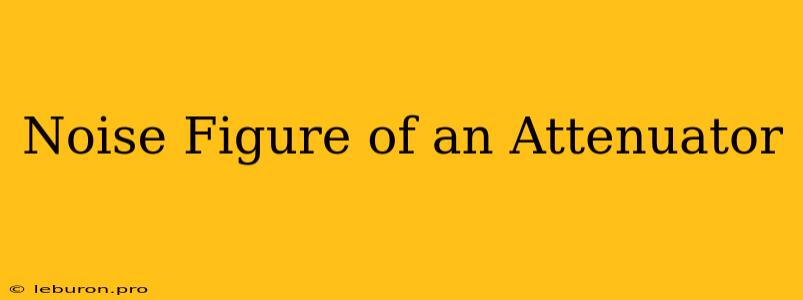The noise figure of an attenuator is a crucial parameter that quantifies its contribution to the overall noise level in a system. Attenuators, by their very nature, reduce the signal strength, but they also introduce their own noise. This noise can be a significant factor in the performance of sensitive receivers, particularly in low-noise applications. Understanding the noise figure of an attenuator is essential for accurately predicting the overall noise performance of a system and making informed design choices. This article will delve into the concept of noise figure in attenuators, explore the factors that influence it, and provide practical insights into its implications for system design.
Understanding Noise Figure
The noise figure (NF) of a device or system is a measure of its degradation of the signal-to-noise ratio (SNR). It represents the ratio of the output noise power to the input noise power, expressed in decibels (dB). A lower noise figure indicates less noise added by the device, resulting in a better SNR.
In the context of attenuators, the noise figure arises from the inherent noise generated within the resistive elements of the attenuator. This noise is predominantly thermal noise, also known as Johnson-Nyquist noise, which is proportional to the temperature and bandwidth of the resistor.
Factors Influencing Noise Figure of an Attenuator
The noise figure of an attenuator is primarily influenced by several factors:
Attenuation Value
The noise figure of an attenuator increases with increasing attenuation. This is because as the signal is attenuated, the relative contribution of the attenuator's internal noise becomes more significant. A higher attenuation value means the signal is weakened, making the inherent noise of the attenuator more prominent in the output.
Resistor Material and Temperature
The material used for the resistive elements in the attenuator plays a significant role in its noise figure. Resistors made of materials with lower thermal noise coefficients will contribute less noise. Additionally, temperature has a direct impact on the noise figure. As the temperature increases, the thermal noise generated by the resistors also increases, leading to a higher noise figure.
Bandwidth
The noise figure of an attenuator is also dependent on the bandwidth of the signal passing through it. A wider bandwidth results in a higher noise figure. This is because a wider bandwidth allows more noise components to pass through the attenuator, contributing to the overall noise level.
Attenuator Type
Different types of attenuators, such as fixed attenuators, variable attenuators, and step attenuators, can exhibit varying noise figures depending on their design and construction. Some attenuators are designed to minimize noise contributions, while others may prioritize factors like cost or compactness over noise performance.
Impact of Noise Figure on System Performance
The noise figure of an attenuator directly impacts the overall noise performance of a system, especially in low-noise applications. Here are some key implications:
Signal Sensitivity
A high noise figure can significantly degrade the signal sensitivity of a receiver. The higher the noise figure, the weaker the signal that can be reliably detected. This is particularly critical in applications where faint signals are being measured, such as in radio astronomy or medical imaging.
System Dynamic Range
A high noise figure reduces the dynamic range of a system. Dynamic range refers to the ratio between the strongest and weakest signals that can be reliably processed. A high noise figure can limit the system's ability to distinguish between weak signals and noise, thereby reducing its overall dynamic range.
Receiver Performance
In receiver systems, the noise figure of an attenuator can significantly impact the overall noise performance of the receiver. If the attenuator contributes a significant amount of noise, it can mask the desired signal and degrade the receiver's ability to accurately detect and process the signal.
Choosing an Attenuator with Low Noise Figure
When choosing an attenuator for a system, it's crucial to consider the noise figure requirement. Here are some factors to guide your selection:
Application Needs
Consider the sensitivity and dynamic range requirements of your application. For low-noise applications, such as those involving faint signals or high sensitivity, a low-noise attenuator is essential.
Frequency Range
The frequency range of operation can influence the noise figure of the attenuator. Some attenuators are designed for specific frequency bands and may have lower noise figures within those ranges.
Power Handling
The power handling capabilities of the attenuator are also important. Higher power signals may require attenuators with higher power handling capabilities, which could affect the noise figure.
Cost and Size
Cost and size considerations may also factor into the decision. While low-noise attenuators can offer superior performance, they may come at a higher cost or larger size compared to standard attenuators.
Conclusion
The noise figure of an attenuator is an important parameter to consider in system design, particularly in applications demanding high sensitivity and low noise. Understanding the factors that influence noise figure, such as attenuation value, resistor material, temperature, and bandwidth, is crucial for selecting the right attenuator for a particular application. By carefully choosing attenuators with low noise figures, engineers can minimize noise contributions and enhance the overall performance of their systems.
